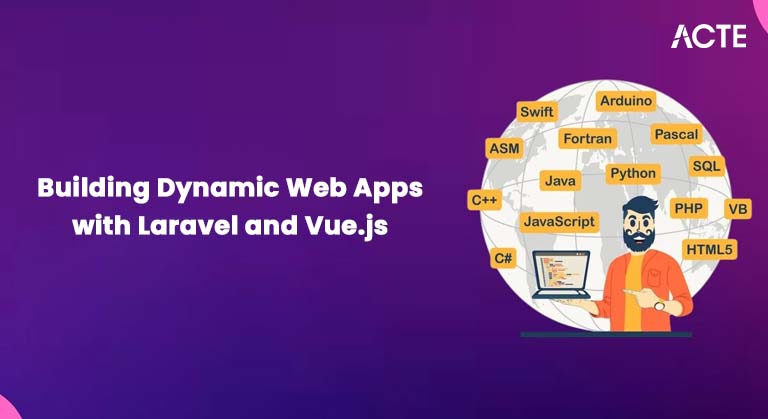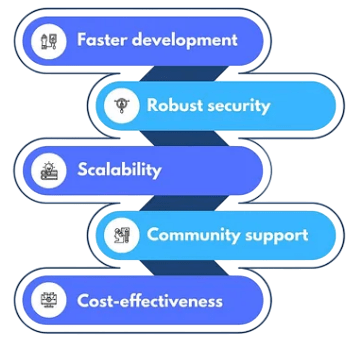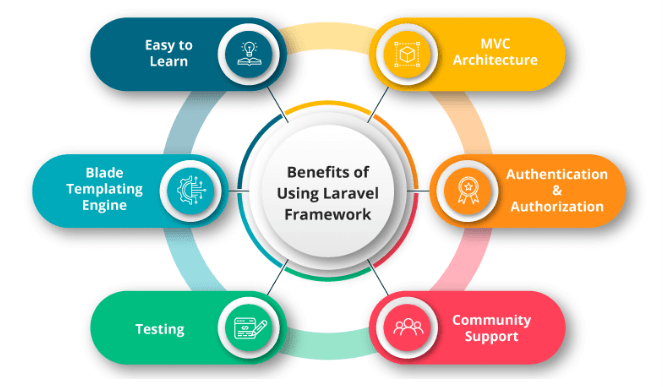
- Introduction
- Why Laravel and Vue.js?
- Setting Up the Development Environment
- Creating a New Laravel Project
- Integrating Vue.js with Laravel
- Building a Dynamic Web Application
- Deploying Your Laravel + Vue.js Application
- Conclusion
Introduction
Building dynamic web applications requires a combination of frontend and backend technologies that integrate smoothly to deliver a responsive and efficient user experience. Laravel, a robust PHP framework, and Vue.js, a modern JavaScript framework, are two popular technologies that work exceptionally well together for full-stack web development. Together, they allow developers to build scalable, maintainable, and interactive applications with ease. Laravel handles the backend side of development. It offers an elegant and expressive syntax, simplifies routing, manages databases with Eloquent ORM, and includes built-in support for features like authentication, caching, and API development in Web Designing Training. Laravel also integrates seamlessly with frontend tools, making it a strong foundation for any web application. Vue.js, on the other hand, takes care of the frontend. It provides a reactive, component-based architecture that makes building interactive user interfaces straightforward. With Vue, developers can create reusable components, manage state efficiently, and handle real-time updates for a smooth and modern user experience. In this guide, we will walk you through the entire process of building a dynamic web application using Laravel and Vue.js. You will learn how to set up both environments, integrate Vue into a Laravel project, build and organize components, and connect them to your backend through API calls. By the end, you’ll be equipped to create robust, real-time applications that offer both powerful backend functionality and seamless frontend interactivity.
Are You Interested in Learning More About Web Developer? Sign Up For Our Web Developer Courses Today!
Why Laravel and Vue.js?
Laravel and Vue.js are often chosen together for web development because they complement each other perfectly, offering a seamless full-stack development experience. Laravel is a robust PHP framework that excels at handling backend tasks such as routing, authentication, database interactions, and API development. Vue.js, on the other hand, is a progressive JavaScript framework ideal for building dynamic, responsive user interfaces on the frontend. When combined, they provide a complete solution for developing modern web applications that are both scalable and maintainable, which is essential knowledge for How to Become a PHP Developer. One of the main reasons developers choose Laravel and Vue.js is their ease of integration. Laravel comes with built-in support for Vue and Laravel Mix, making it straightforward to compile Vue components and manage frontend assets. This tight integration allows developers to create interactive, single-page applications (SPAs) or enhance traditional multi-page apps with Vue’s reactive features without needing to restructure the entire backend. Laravel handles complex backend operations like authentication, form validation, and data persistence, while Vue.js manages the real-time interactivity and user experience. With tools like Axios and Laravel Echo, developers can implement real-time features such as chat apps, notifications, and live updates with minimal effort.

Additionally, both Laravel and Vue.js have strong communities, extensive documentation, and a wealth of learning resources, making them accessible even for developers who are new to full-stack development. Choosing Laravel and Vue.js together allows teams to build efficient, high-performance applications that deliver excellent user experiences while maintaining a clean and organized codebase throughout the development process.
Setting Up the Development Environment
- Install Required Software: Begin by installing essential software such as a code editor (like Visual Studio Code), Git for version control, and your chosen runtime environments such as Node.js for JavaScript or PHP for backend projects.
- Set Up Version Control: Configure Git by installing it and setting up your user credentials. Initialize a Git repository in your project folder to manage code changes effectively.
- Install Package Managers: For JavaScript projects, install npm or Yarn to manage libraries and dependencies. For PHP projects, ensure Composer is installed to handle packages efficiently.
- Configure Database: Install and set up a database system such as MySQL, PostgreSQL, or SQLite. Create necessary databases and users for your project and configure connection settings.
- Install Development Frameworks: Depending on your project, install frameworks like React, Laravel, or Angular via command-line tools or package managers to streamline development and understand What is Angular.
- Set Up Local Server: For backend or full-stack projects, configure a local development server. Use tools like XAMPP, MAMP, or Laravel’s built-in server to run your app locally.
- Configure Environment Variables: Create and configure environment variable files to manage sensitive information like API keys, database credentials, and configuration settings separately from your codebase.
- Install Composer: Ensure Composer, the PHP dependency manager, is installed on your system. Composer is required to create and manage Laravel projects and their dependencies.
- Check PHP Version: Verify that your system has PHP installed, preferably version 7.3 or higher, as Laravel requires a compatible PHP version to run smoothly in Web Designing Training.
- Create Laravel Project: Open your terminal or command prompt and run the command composer create-project prefer-dist laravel/laravel project-name, replacing project-name with your desired project folder name.
- Navigate to Project Directory: After the installation completes, move into the project folder using cd project-name. This sets the working directory for further commands.
- Configure Environment Settings: Copy the .env.example file to .env by running cp .env.example .env (on Windows, copy manually). Update this file with your database credentials and other environment-specific settings.
- Generate Application Key: Run the command php artisan key:generate to generate a unique application key, which is used for encryption and securing user sessions.
- Run Development Server: Start the Laravel development server with php artisan serve. This launches a local server, usually accessible at http://localhost:8000, where you can view and test your new Laravel app.
- Plan Your Application Structure: Start by outlining the features and user flow of your web app. Decide on the architecture, including frontend, backend, and database components.
- Choose the Right Technologies: Select appropriate frameworks and tools for your app, such as React or Vue.js for the frontend and Laravel, Node.js, or Django for the backend, based on your project needs.
- Set Up the Development Environment: Install and configure necessary software, code editors, package managers, and local servers to streamline your development process.
- Develop Interactive Frontend Components: Use JavaScript frameworks to build responsive and reusable UI components that react to user input and update dynamically without page reloads, which aligns with the principles in the Basics of Service Design.
- Implement Backend Logic and APIs: Create server-side code to handle business logic, process data, and manage communication between the frontend and databases using RESTful or GraphQL APIs.
- Connect to a Database: Design and set up a database to store and retrieve data efficiently. Use ORM tools or direct queries to interact with your database from the backend.
- Test and Deploy Your Application: Perform thorough testing to catch bugs and ensure functionality. Once ready, deploy your app to a hosting service or cloud platform to make it accessible to users.
Interested in Obtaining Your Web Developer Certificate? View The Web Developer Courses Offered By ACTE Right Now!
Creating a New Laravel Project

Integrating Vue.js with Laravel
Integrating Vue.js with Laravel provides a seamless way to build modern, reactive web applications using a powerful backend framework combined with a flexible JavaScript frontend. Laravel comes with built-in support for Vue.js through Laravel Mix, which simplifies asset compilation and integration. This allows developers to quickly scaffold a full-stack application where Vue.js handles the dynamic interface and Laravel manages the backend logic, routing, and data. To begin integrating Vue.js with Laravel, you typically start by installing a fresh Laravel project. Once set up, you can use Laravel Mix, a wrapper around Webpack, to compile Vue components and other frontend assets, which is useful to understand when comparing AngularJS Vs Angular 2 Vs Angular 4. By default, Laravel includes Vue in the resources/js/app.js file, making it easy to start creating Vue components right away. You can register components globally or import them locally as needed. Vue components are ideal for handling interactive features such as real-time form validation, dynamic tables, modals, and more. Data can be passed between Laravel and Vue using API endpoints created with Laravel’s routing and controllers, while Vue uses tools like Axios to fetch and send data asynchronously. Laravel also supports features like CSRF protection, authentication, and broadcasting, which integrate smoothly with Vue for secure and real-time functionality. You can enhance your Vue components further by incorporating Vue Router and Vuex for client-side routing and state management. By integrating Vue.js into a Laravel project, you can build rich, single-page applications or enhance traditional multi-page apps with dynamic features, offering users a responsive and modern experience while keeping development efficient and organized.
Do You Want to Learn More About Web Developer? Get Info From Our Web Developer Courses Today!
Building a Dynamic Web Application
Deploying Your Laravel + Vue.js Application
Deploying a Laravel and Vue.js application involves several key steps to ensure that both the backend (Laravel) and frontend (Vue.js) are properly built, configured, and served in a production environment. Laravel serves as the backend framework, handling routing, API logic, and data management, while Vue.js powers the interactive frontend components. Before deployment, you need to make sure your application is production-ready by optimizing configurations, securing sensitive data, and building frontend assets. First, compile your Vue.js components using Laravel Mix by running npm run prod. This command generates optimized JavaScript and CSS files that are ready for production in the context of TypeScript Vs JavaScript. These compiled assets are typically stored in the public directory and served directly to users. Next, set your Laravel environment file (.env) to production settings. Make sure to configure environment variables such as APP_ENV=production, APP_DEBUG=false, and database credentials. Run php artisan config:cache and php artisan route:cache to optimize performance by caching configuration and route data. When deploying to a web server (such as Nginx or Apache), ensure the web root points to Laravel’s public directory. Also, make sure necessary permissions are set for storage and cache directories. You may also want to configure a process manager like Supervisor for queue workers or use tools like Laravel Forge, Envoyer, or Docker for smoother deployments. Finally, confirm your application is secure by using HTTPS, setting correct file permissions, and updating all dependencies. With proper deployment, your Laravel and Vue.js app will be live, efficient, and ready for real-world users.
Conclusion
Laravel and Vue.js together form a powerful full-stack solution for building modern, dynamic, and highly interactive web applications. Laravel, known for its elegant syntax and robust backend features, handles routing, database management, API creation, authentication, and more. Vue.js complements it perfectly by offering a lightweight and flexible frontend framework that allows developers to build reactive user interfaces with ease. This combination allows for clear separation of concerns while enabling seamless communication between the frontend and backend via RESTful APIs or Laravel’s built-in support for tools like Axios and Laravel Echo. Throughout this guide, you have learned how to set up a Laravel application integrated with Vue.js, structure and build reusable Vue components, manage state and props, and fetch dynamic data from the backend in Web Designing Training. You’ve also seen how to compile and optimize frontend assets using Laravel Mix, making your application production-ready. By combining Laravel’s backend power with Vue’s real-time interactivity, you can create user experiences that feel fast and responsive without compromising stability or scalability.Deploying your Laravel and Vue.js application involves finalizing environment configurations, building production assets, setting correct permissions, and choosing the right hosting solution. Whether you use shared hosting, a VPS, or cloud services like AWS or DigitalOcean, proper setup ensures performance and security. Using Laravel and Vue.js together allows you to build applications that are not only functional but also modern, efficient, and user-friendly. Whether you are developing small projects or large-scale systems, this stack provides the tools and flexibility to scale with your needs.


